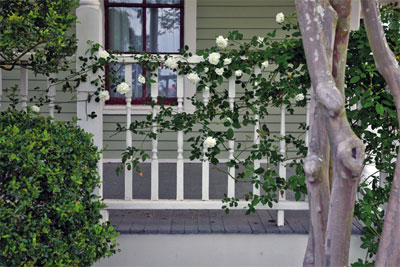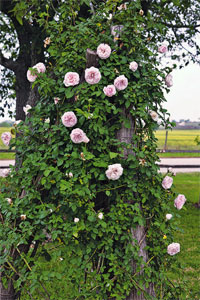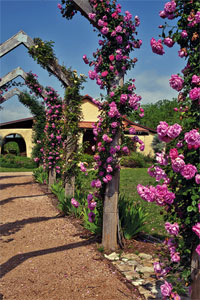Rose Cuttings: December 2013

Roses can be trained on many structures, ranging from fences to pillars to trellises. Photos provided by Mike Shoup.
What’s “UP” With Roses
by Mike Shoup
Fences
Fences are ready-made structures for both shrub and climbing roses. Chain link, chicken wire and barbed wire fences that lack any redeeming quality of beauty beg to be covered with all types of climbing roses. Split rail, picket and ornamental fences can simply be accented with shrubs or mannerly climbers.
Pillars and Tripods
 Pillars are vertically situated posts and poles of varying heights. A mailbox perched on a 4-foot-tall post is an example of a small pillar. Six- to 8-foot cedar posts along a border in a flowerbed or even in the lawn will support roses. Chains and rope can connect pillars for a festooned effect using draping roses. Rose canes can be trained in crisscross fashion, vertically up the sides, or circling around the posts. (More manipulation of the canes usually yields more bloom.)
Pillars are vertically situated posts and poles of varying heights. A mailbox perched on a 4-foot-tall post is an example of a small pillar. Six- to 8-foot cedar posts along a border in a flowerbed or even in the lawn will support roses. Chains and rope can connect pillars for a festooned effect using draping roses. Rose canes can be trained in crisscross fashion, vertically up the sides, or circling around the posts. (More manipulation of the canes usually yields more bloom.)
Tripods are an expanded version of the pillar, with three posts positioned several feet apart at the base and tied together at the top. Roses can be planted in the middle and trained up all three sides, or one climber can be trained on each post. The latter method can create hollow openings in the center of the tripod for bowers or caves for children to hide in. Obviously, thornless roses like Lady Banks or Zephirine Drouhin would have to be used in this situation.
Trellises
Trellises can be used to form screens or provide large colorful single-planed displays. Trellises can provide privacy from neighbors along the driveway or between houses, hide unsightly air conditioners, television discs, and garbage cans. They provide a barrier or enclosure for a garden or separate areas of the garden, like between a swimming pool and a patio. They require rigorous training schedules to be at their best, since they often are used in highly visible places.
Arches
 Arches connect one area of a garden with another or provide entryways or exits from a garden. They cover a walkway or garden path from one side to the other, so clear passage under the structure is allowed. Roses can be trained from one or both sides, but total overhead coverage is desired to create the most dramatic presentation.
Arches connect one area of a garden with another or provide entryways or exits from a garden. They cover a walkway or garden path from one side to the other, so clear passage under the structure is allowed. Roses can be trained from one or both sides, but total overhead coverage is desired to create the most dramatic presentation.
A pergola is simply a series of interconnected arches that cover a walkway. Again, two separate areas of the garden can be connected, but the best effects are when the pergola creates an alleé leading to a feature like a seated area or a sculpture. The walkway can be of brick, stone or even grass, but only one rose variety should be planted along the sides of the pergola and allowed to cover. This ties the structure together architecturally and gives a much better sense of continuity. With many diverse plantings the pergola would appear hodgepodge and disconnected.

